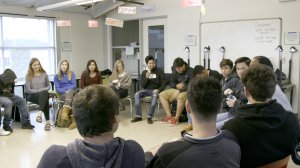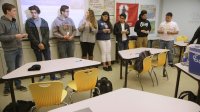13 Powerful SEL Activities
Build social and emotional skills into any class.
Summit Preparatory Charter High School in Redwood City, California, uses a variety of activities in the weekly, 90-minute Habits, Community, and Culture (HCC) class, where students learn Habits of Success and develop social and emotional learning (SEL) skills. The school has developed an HCC curriculum for grades nine through 12 and hired two full-time teachers for HCC, but Summit’s academic teachers also use some of these activities to build SEL skills and deepen their relationships with their students. Cady Ching, a biology and AP environmental science teacher at Summit, incorporates opening activities into all of her classes: “In my freshman classes, we do them every class period.”
Here are some of the opening, group sharing, and closing activities that teachers use at Summit:
Opening Activities
1. Mindfulness: The benefits of mindfulness range from improved working memory to stress reduction. Here are two ways Aukeem Ballard, an HCC teacher, facilitates mindfulness:
- Visualization to release stress: Have your students imagine what stress looks and feels like inside their body, and then ask them to release it. “The mindfulness practice makes you think the stress is coming off your body,” says Geoffrey, a 12th-grade student.
- Noise isolation: There are a variety of sounds that your students hear when they’re in your classroom, from students walking in the hallway to outdoor construction noise. Have your students focus on one noise and describe it to themselves and recall the last time they interacted with it.
To get more tips, check out Ballard’s “When Mindfulness Feels Like a Necessity."

2. Name the emotion you’re bringing to class: Have each student call out the emotion they’re feeling. This helps each student know how they and other students are feeling, what different emotions look like, and how to better interact with their peers based on how they’re feeling.
3. Write down, rip up, and throw away your stress: Have your students write down their expectations and insecurities, rip them up, and throw them away. This emotional check-in takes about three minutes. By acknowledging how your students are feeling at the start of each class, you’ll acknowledge their barriers to learning and create a safe space for your students to overcome them.
4. Growth mindset vs. fixed mindset share-out: Have your students share moments when they have demonstrated a growth and fixed mindset.
5. Quote of the day: Introduce a quote relevant to what your students are learning or to a shared experience—for example, an act of violence in the community. You can facilitate a whole-class discussion, group students into pairs, or have each student share a one-word response to the quote. This gives students the space to reflect on their beliefs and experiences and whether they agree or disagree with the quote and other students’ opinions, and it gives them insight into their peers’ perspectives and feelings.
6. Where we came from: Collect baby pictures from your students. Project one baby picture at the start of class, have your students guess who it is, and then have the featured student share something about their childhood.
7. Starting positive: Have each student tape a sheet of paper to their back and then walk around and write positive qualities about their peers on their backs.
8. Motivational moment: Have two students start the class with a three- to five-minute presentation—and come up with two or three discussion questions—based on their interests. The presentation must be related to the course content in a real-world context. “Many students include a video for visuals and increased engagement, but it’s optional,” says Ching. Have the rest of the class partner up to discuss their questions for one minute and then give them the opportunity to share out to the whole class. This exercise gives your students insight into their peers’ interests.
Summit Preparatory Charter High School
Enrollment
388 | Charter, SuburbanPer Pupil Expenditures
$8917 School • $9658 DistrictFree / Reduced Lunch
47%DEMOGRAPHICS:
Group Sharing
9. Circle sharing: To encourage active listening, create small groups. Have your students position their chairs in a circle so everyone can make eye contact. To strengthen empathy, you can facilitate deeper discussion around what a student shares by asking, “Why did that student share what they did?” or “What perspective is that student coming from?”
When discussing emotionally charged topics, it’s important to have guidelines to foster a safe space. Summit uses the Courageous Conversation protocol created by Glenn E. Singleton when discussing race. The protocol is guided by four agreements—stay engaged, experience discomfort, speak your truth, and expect and accept nonclosure. Here is an example of elementary school discussion guidelines from School 21.

10. Write a poem from someone else’s perspective. Have your students choose someone they don’t know. This helps them to understand that they don’t “need to be best friends with someone to empathize with them,” explains Ballard.
11. Have a conversation with someone you don’t know. Have your students pair up with a student they don’t know and provide the pairs with five questions to ask each other. Each student introduces their partner to the class, speaking as if they were their partner, while the rest of the class looks at the student being introduced. “We don’t see people sometimes,” says Ballard, “and this exercise helps students to see each other more deeply.”
12. Play interest and identity-related bingo. Instead of squares filled with numbers or vocabulary words, create cards with information relating to your students. Summit’s Bingo cards have things like “‘I like to read’ or ‘I was born in a different country,’” says Armando, a ninth-grade student.
Closing Activity
13. Appreciation, apology, aha: Have your students get in a circle and share an appreciation, apology, or realization with the group. Students in Ballard’s class have shared things like:
- I would like to appreciate Brenda for facilitating the conversation in our small group.
- I would like to thank everyone for taking this class seriously.
- I apologize to everyone for having my headphones in for half of the time.
Encourage authentic and timely apologies. Apologizing for something that happened a long time ago has less impact than apologizing for something that happened that day or week. Let your students know that they don’t have to name who they’re apologizing to when they apologize for what they did.
Help students share helpful, not harmful words. “I often say, ‘Appreciations, apologies, and ahas should be something that you genuinely think will be useful for people to hear,’” says Ballard.
Have your students snap, clap, or shake both hands when they hear something that resonates with them. “We snap to let people know that we hear them without exerting our own voice in their narrative,” explains Ballard. Students shake their hands when peers share things that are emotionally charged. Ballard often gets this started by saying, “Let’s shake it up for that.”
“When you pay attention to each other, not only does it build a sense of community, but we’re more able to understand other people,” says Janet, a 12th-grade student. “If you're able to understand people at a younger age, you could work better with them as adults. That changes how the future generations will be. People can be more accepting, more helpful towards each other.”
